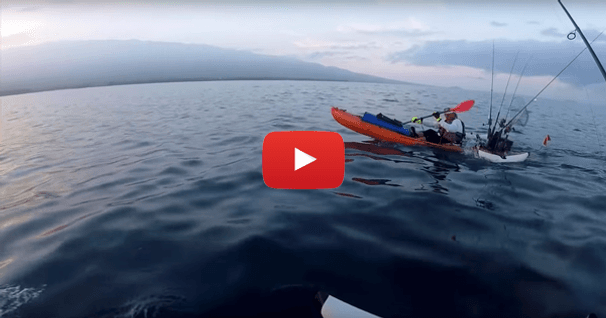Paddle-Float Rescues and Assists
The paddle float can be a very handy device if you use it often enough to become accustomed to its idiosyncrasies and its many uses. It's similar to a waterproof pillowcase with an air chamber or two that you inflate by blowing into it. The best way to get used to your paddle float as a rescue and bracing aid is to; you guessed it, practice, practice, and practice. Practice in calm water, cold water and rough water until you develop confidence in what you can do with it.
Primary use: the paddle rescue float was initially designed as a solo rescue aid to help you use your paddle as an outrigger to stabilize your boat for re-entry from deep water. It takes the place of another boater in an assisted rescue situation. Here's how it works:
*You've wet exited successfully, have your paddle in hand and have a grip on your cockpit rim. Stick a leg in the overturned cockpit to keep your boat from swimming away. This will allow you to have both hands free while your PFD floats you (you are wearing it, aren't you?). Tuck your paddle between your legs and ride it like a broomstick to keep it in place. Remove your paddle float from where its stowed within easy reach behind your seat or under the bungies on your back deck. Open it up and slide it over the end of your paddle blade and secure the strap around your paddle shaft, this will keep it from floating off once its inflated.
Inflate it fully (both chambers if there are two), don't worry if you scoop water into the part that goes over your paddle, it actually helps provide ballast. You're outrigger is now ready to go, time to get that leg out of the boat, flip it upright and slide the bare paddle blade under the bungies behind your seat. Be sure to slide the paddle blade flat under all the bungies on both sides of the boat to keep it as perpendicular to your kayak as possible. You can also hold the paddle in place by curling your fingers around the paddle shaft and your thumb around the back of your cockpit.
In your position next to your cockpit you should now have both hands on the cockpit rim and your body stretched out along the paddle shaft. Hook an ankle and knee over the paddle shaft and push with your leg as you pull with your arms to launch yourself up onto your cockpit. Turn gently toward your stern always keeping an arm stretched out on your outrigger paddle. While keeping your weight toward your outrigger, crawl onto the back deck until you can hook your legs into your cockpit. Continue keeping an arm outstretched on your outrigger and shinny back down into your cockpit on your stomach. Turn over when your hips are over your seat and try to maintain some weight on your outrigger at all times, otherwise you will end up in the water on the side away from your outrigger.
Once you are seated, its time to pump the water out. I like to carefully and quickly move my outrigger from behind me to the front of me, this way you can trap your paddle under your elbows while you use your bilge pump to empty your boat (you did keep it within easy reach, didn't you?). If the water is rough, you can put your skirt on and push the pump down the body tube to keep water from going in as fast as it comes out. You can still use your paddle and paddle float to provide stability while you put your skirt on. I don't remove the float until I'm really ready to paddle again. Simply release some of the air, pull in off the paddle blade and stow it under the deck bungies ahead of you in case you need it again soon.
Other uses:
- As a bracing aid: when practicing a very committed high brace, the fear of capsize often interferes with developing good technique. If you practice with the paddle float on your outstretched blade, you'll be able to come back up from an extreme brace easily, which will give you enough confidence to commit more fully and pay closer attention to the finer points.
- As a rolling aid: pretty much all of the above applies. Using the rescue float in this way gives you time to refine body position and see better what you are doing wrong and right.
- In a pinch they even make a fine camp pillow.
Michael Gray contributes from the island of Roatan in the western Caribbean. For lodge-based paddling trips on a pristine coral reef and 80 degree water, check out www.uncommonadv.com
Related Articles
In this video, Chad is kayak fishing in the river in Happy Valley, Pennsylvania. He shares important…
Watch as a pair of kayak anglers experiences a sinking kayak several miles from shore. Thank goodness…
Whether you paddle with a group or you enjoy paddling solo, there may come a time where you would need…
The traditional All In Recovery takes some time and a good deal of orchestration and manipulation to…



